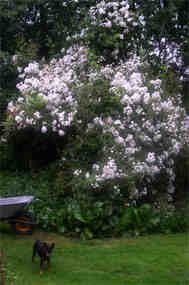Old roses: Rosa Rambling Rector. (1910, unknown breeder(s))
Posted by Fiona Nevile in Flowers | 9 comments
Rambling rector rose in our garden
“We ought to have our summer party in June.” Danny declares each year. But we never do. The cottage is small, so big parties take place in the garden. It can be chilly in June and a garden party could be a disaster. So R. Rambling Rector is generally just enjoyed by us and the Min Pins.
Our Rambling Rector rose was picked by Roger Sagger (R&R Sagger’s of Newport, Essex) as the perfect rambling rose to cover a large 10′ tree stump. It has hundreds of sprays of small, creamy-white, fragrant flowers with yellow stamens. I had wanted the lovely Kiftsgate rose and I am so pleased that I took Roger’s advice as the rose is perfect for the spot. We love the semi-double flowers. And so do the honey bees.
In the second year R. Rambling Rector began to make its presence felt. The rose is thought to be a cross between Rosa Multiflora and Rosa Moschata. Peter Beales describes the rose as Moschata, “Shakespeare’s Musk”. If you have the space this is a wonderful, heartening rose to grow. Beware, once established you would find it hard to take a holiday in June. The flowering month must vary in different parts of the U.K. as the Peter Beales website says that the rose flowers in July.
The maximum spread of Rambling Rector is 20′ x 20′. It’s a tough rose. Our specimen’s roots are in a dry shady spot but this has not held the rose back. It has been in the garden for about 14 years and has never been fed.
It flowers on new wood so needs to be cut back straight after it has finished flowering. If you are planning to let this rose ramble through a tree keep a beady eye on it. Don’t let it create a dense canopy. This happened to a willow tree that we once had. The people who lived here before planted the vigorous clematis Montana that climbed onto the top most branches. It snowed very hard for a couple of hours one winter and the weight of the snow on the canopy brought the tree down.
Leave a reply





This gorgeous frothy rose makes the biggest impact of all the roses in our garden. We open the back door to find it spilling over the first half of the herbaceous border. It has climbed into the plum trees in the garden next door and splashes over the shrubs below like a floral Niagara. It flowers throughout June. For a whole month we savour it from the first buds to the last few handfuls of flowers.
Regard Telkom University
“pinkish hue”
Could have something to do with the high nitrogen level in the soil around the evergreens or even somthing in the type of evergreen itself. Also, copper in soil can turn white flowers pink, so there may copper naturally in the soil. Yay to copper, I say.
Just found this page and it’s delightful. thanks for sharing your love of gardening.
Hello J. Wicks
Thanks so much for leaving such a useful comment. I had no idea about the copper.
Hi Rick,
Your roses sound fabulous and must make a stunning display. I have not seen a rambling rector with a pinkish hue. How interesting.
I have three large ramblers at the bottom of my garden in Seattle WA. One is The Garland the other Rambling Rector and the third an unidentified musk. They have all climbed into tall evergreens and make a spectacular display, cascading down like waterfalls. My Rambling Rector has a pinkish hue unlike a lot of the pictures I have seen on the web.
Hello Tea,
I’m not sure what the climate is like in Ontario, Canada. This rose is tough. I would imagine that it would be happy in any climate where roses grow. But I am no expert so it would be wise to check. This is the one rose that we really look forward to.
However, it only flowers once. And that is its charm. It cries out to be savoured.
Thanks for drooping by.
Hi Sara,
How lovely to inherit roses from your husband’s grandmother. It sounds so romantic and I really enjoyed your rose tour, you have some beautiful roses on your Yorkshire farm. They are a joy.
Mrs Boss is doing well. She is getting a bit more protective of her/your eggs.
Hi Anglefeet,
I enjoy Gardener’s Question Time but must have missed that one. It is easily tamed if it is pruned just after flowering. We forgot to do this last year but it will be given a good shave and a haircut in July this year.
Thanks for leaving a comment.
They were talking about the Rambling Rector on last week’s Gardners Question Time. A lady was having trouble controlling her Rector and “he” was overpowering her other, more ladylike roses. It looks delightful.
Hi Fiona,
I love your rose. We have four climbing roses in our garden, inherited from my husband’s Grandma. Thanks for all the interesting information.
Sara from farmingfriends
What a beautiul mass of roses! I`m going o check and see if this would grow well here in Ontario Canada.
Would love to see more of your garden and also your cottage.
tea
xo